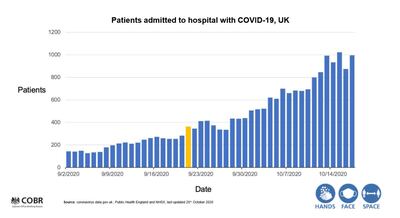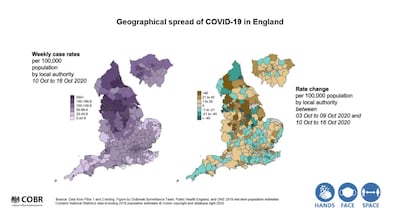There could be as many as 90,000 new Covid-19 infections a day in the UK, the chief scientific adviser has warned, compared to the 21,242 officially confirmed cases announced on Thursday.
The pandemic modelling group (SPI-M) that advises the government estimated a daily incidence rate of between 53,000-90,000 according to data collected until October 20.
"Obviously with that number of infections, you expect to see an increase in hospitalisations as well. So the number of infections overall across the country continues to increase," Patrick Vallance told a press conference.
Britain has suffered Europe's worst death toll from coronavirus, with more than 44,000 deaths.
Patients admitted to hospital suffering from the virus continue to rise, with numbers hovering around 1,000 a day.
“It’s worth remembering that the number of infections leads to hospitalisation a week or two later and that in turn has the effect of increasing intensive care unit numbers and of course unfortunately a number of people will die as a result of that and that will increase a week or two after that," Mr Vallance said.
"So we expect to see a delay from the number of infections through to hospitalisation through to the very serious consequences and to death.
The rise in hospitalisations has led to more and more beds getting taken up before the winter.
“The more patients there are with Covid, the more the pressure on the healthcare system overall and the more the other conditions get affected because people don’t have the capacity to deal with it," Mr Vallance said.
"So it’s very important to keep the number of infections down if we are to reduce the number of hospitalisations.”
The R rate – the average of how many people a Covid-positive person would infect - is also on the rise.
It's been on the increase since August as lockdown measures were loosened and now stands between 1.2-1.5. However, this is half the number of 3, which is regarded as the natural figure if no precautions are taken.
Mr Vallance said it “definitely reflects the huge effort people have made to try to adhere to the various measures that are in place".
"The fact that we’re wearing masks, we’re keeping a distance, we’re washing our hands, we’re doing the things that we need to do to try to reduce it has brought the R down but this also means that the epidemic is still growing," he said.
The virus has not been evenly spread across the country, with the north-west particularly hard hit, as this chart shows.
A string of major urban centres in northern England have been put into the highest level of restrictions, known as Tier-3, which means there is a very high risk of Covid-19 spreading.
The greater prevalence of Covid in the north of England is reflected in a far higher level of hospitalisations.
Swathes of northern England, including the cities of Liverpool and Manchester, have been placed under more stringent restrictions, joining Scotland, Northern Ireland and Wales with tighter curbs to help stem spiking infections.
The situation in Greater Manchester led to a public spat between local figures and central government, as the latter ordered a Tier-3 lockdown despite the protestations of the former. Manchester's mayor Andy Burnham had demanded the UK government offer greater support to workers who would lose their jobs if tighter restrictions were put in place.







